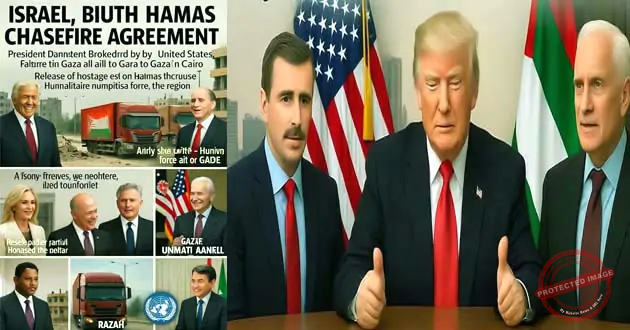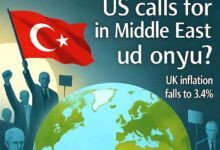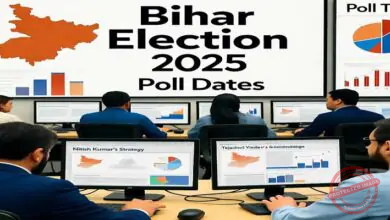
India News Reporter Staff | October 10, 2025 | Jerusalem/Tel Aviv | In a historic development that has sent ripples of hope across the Middle East and beyond Israel and Hamas have reached an agreement on the first phase of a U.S.-brokered peace plan aimed at ending the protracted two-year war in Gaza. Announced late Thursday by President Donald Trump’s administration, the deal marks a tentative pause in hostilities, with immediate provisions for hostage releases, humanitarian aid corridors, and a partial withdrawal of Israeli forces from key areas in the besieged enclave. The breakthrough comes after months of grueling indirect negotiations in Egypt and Qatar, brokered under intense diplomatic pressure from Washington, and is being hailed as a potential turning point in one of the world’s most intractable conflicts.
The agreement, detailed in a joint statement from the White House and the Israeli Prime Minister’s Office, outlines a multi-phased roadmap. Phase One, effective immediately upon implementation expected within 72 hours, includes the release of 50 Israeli hostages held by Hamas in exchange for 200 Palestinian prisoners currently detained in Israeli facilities. It also mandates a seven-day ceasefire during which 500 trucks of essential aid food, medical supplies, and fuel will enter Gaza daily through the Rafah and Kerem Shalom crossings. Israeli Defense Forces (IDF) will pull back from northern Gaza districts, allowing displaced civilians to return to their homes, while Hamas commits to halting rocket fire and demilitarizing certain tunnels used for smuggling.
‘This is not just a ceasefire; it’s the beginning of the end of a nightmare that has claimed over 40,000 lives and displaced millions,’ said U.S. Secretary of State Antony Blinken during a press briefing in Washington. President Trump, who personally championed the deal, credited his administration’s ‘tough but fair’ approach, including targeted strikes on Hamas leadership earlier this week that killed six senior operatives in Qatar. ‘We told them: No more games. Release the hostages, or face the consequences. Today, peace is winning,’ Trump declared on social media, drawing both praise and criticism for his unorthodox tactics.
A Glimpse of Hope in Gaza’s Ruins
For the beleaguered residents of Gaza, the news arrived like a fragile dawn after endless nights of bombardment. In Gaza City, now a ghost town of shattered buildings and rubble-strewn streets, small crowds gathered in makeshift squares, their faces etched with exhaustion but flickering with cautious optimism. ‘We’ve buried our children, lost our homes how can we trust this won’t shatter like the last truce?’ said Aisha Al-Masri, a 42-year-old mother of four, speaking to reporters near the Wadi Gaza checkpoint. Yet, as Israeli tanks rumbled southward in the first signs of withdrawal, families began tentative returns, carrying salvaged belongings on donkey carts. The United Nations World Health Organization (WHO) estimates that Gaza’s health system, already ‘on the brink of collapse,’ will require at least $7 billion for reconstruction, with over 80% of hospitals non-functional due to power shortages and supply blockades.
The war, ignited by Hamas’s October 7, 2023, attacks that killed 1,200 Israelis and took 250 hostages, has morphed into a humanitarian catastrophe. Palestinian authorities report more than 42,000 deaths, predominantly civilians, while Israeli strikes have leveled entire neighborhoods. Indirect talks in Cairo, mediated by Egypt and Qatar, had stalled repeatedly over demands for a full Israeli withdrawal and Hamas’s refusal to disarm without guarantees. The U.S. intervention, including economic incentives for reconstruction funded by Gulf allies like Saudi Arabia, tipped the scales. Egyptian President Abdel Fattah el-Sisi has extended an invitation to Trump for a potential signing ceremony in Cairo, underscoring the deal’s regional buy-in.
Global Reactions: Cheers, Skepticism, and Calls for Accountability
World leaders swiftly endorsed the accord, with British Prime Minister Keir Starmer describing it as a ‘moment of profound relief’ for hostages’ families and Gaza’s civilians. ‘This deal, born from unimaginable suffering, offers a pathway to lasting stability,’ Starmer said in a statement from 10 Downing Street. The European Union, France, Germany, and the UK issued a joint communiqué condemning the ‘inhuman’ October 7 attacks while urging Israel to refrain from ‘disproportionate’ responses in Gaza. Vatican Secretary of State Cardinal Pietro Parolin echoed this, calling the Hamas assault ‘indefensible’ but labeling Israel’s operations a ‘massacre,’ and welcoming the truce as a step toward justice.
Not all reactions were celebratory. Pro-Palestinian activists, including climate icon Greta Thunberg, decried the deal as ‘a facade for continued occupation,’ referencing her recent detention during an aid flotilla intercepted by Israeli forces. In Tel Aviv’s Hostages Square, where families have vigiled for two years, jubilation mixed with grief relatives of the 50 to be freed embraced tearfully, but demanded the full 100 remaining captives’ return in subsequent phases. Hamas spokesperson Sami Abu Zuhri framed the agreement as a ‘victory for resistance,’ vowing to hold firm on disarmament until a permanent end to the blockade.
Critics in the U.S. Congress, including Rep. Ro Khanna (D-CA), warned that the deal’s fragility could unravel without addressing root causes like settlements in the West Bank. Meanwhile, the agreement’s timing coincides with domestic U.S. turmoil: A government shutdown looms over budget disputes, causing flight delays at major airports like Denver and Newark due to air traffic controller shortages. President Trump dismissed the chaos, linking it to ‘Democrat obstructionism’ and pivoting to foreign policy wins.
Broader Geopolitical Ripples
The Gaza pact reverberates beyond the Levant. In Ukraine, where Russian forces launched a deadly barrage on energy infrastructure last weekend killing five and blacking out Lviv President Volodymyr Zelenskyy pleaded for bolstered Western aid, drawing parallels to Gaza’s fragility. Ukrainian drones, in retaliation, struck a Russian arms factory and oil terminal in Crimea, escalating fears of a harsh winter without power. Poland reported downing Russian drones encroaching on its airspace, heightening NATO tensions.
Economically, markets reacted bullishly: Gold prices, a traditional safe-haven, surged past $4,000 per ounce amid the uncertainty, before dipping 1.6% to $3,973 as truce hopes stabilized sentiment. The U.S. dollar strengthened against the euro and yen, with the 10-year Treasury yield climbing to 4.146%. In Asia, Saudi Arabia’s Riyadh Air announced its inaugural London flight on October 26, signaling normalized aviation amid thawing regional ties.
As Phase One unfolds, the world watches warily. UN Secretary-General António Guterres called for ‘unwavering international support’ to ensure compliance, warning that failure could plunge the region into deeper chaos. For now, in the shadow of Gaza’s minarets, a fragile peace flickers a testament to diplomacy’s endurance, and a reminder of how swiftly hope can turn to heartbreak.
(India News Reporter is committed to delivering unbiased, in-depth coverage of global events with an Indian perspective. For updates, visit indianewsreporter.com.)








